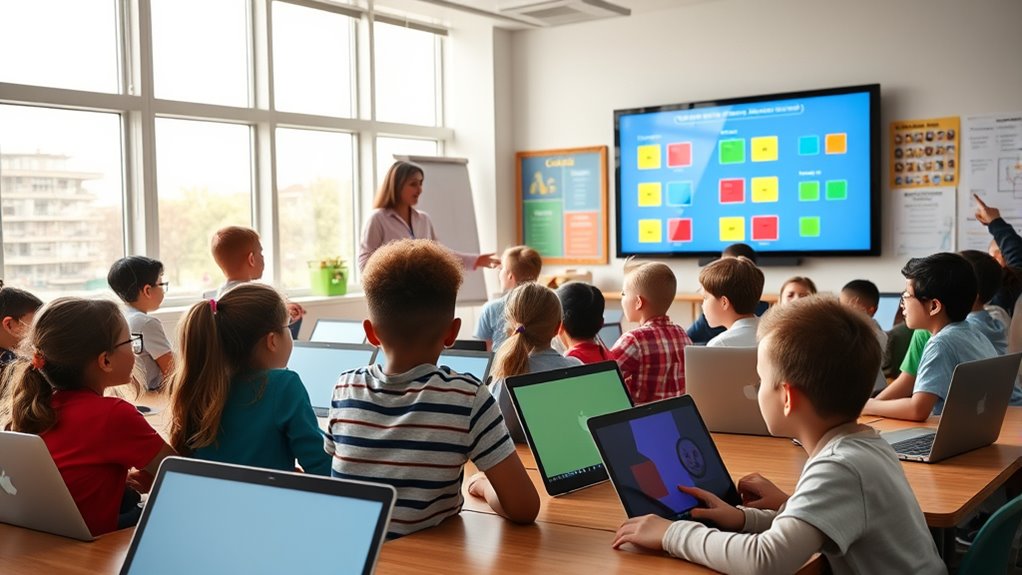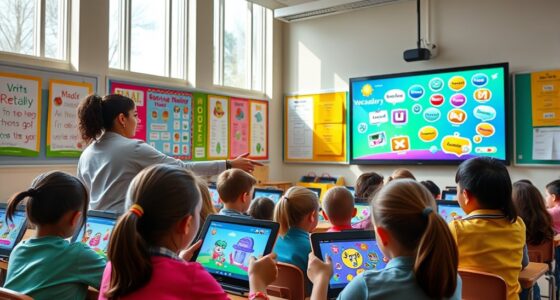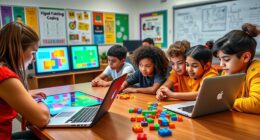Teaching coding with visual programming languages makes learning easier and more engaging. You can simplify complex concepts by using tools like Scratch or Blockly that focus on visual logic and interactivity. These platforms help learners experiment and develop problem-solving skills while building confidence. Integrating fun projects like stories or games keeps students motivated. If you keep exploring, you’ll discover more strategies to make coding accessible and enjoyable for everyone.
Key Takeaways
- Use block-based platforms like Scratch to introduce fundamental programming concepts visually.
- Incorporate interactive tutorials and project-based activities to enhance engagement and understanding.
- Scaffold tasks progressively to build confidence and prevent cognitive overload for beginners.
- Encourage collaboration through group projects to develop problem-solving and teamwork skills.
- Connect projects to real-world interests to increase motivation and demonstrate practical applications.
Benefits of Using Visual Programming Languages in Education

Visual programming languages make learning to code more accessible by removing complex syntax and focusing on intuitive, visual representations of logic. This approach engages learners through interactive tutorials that simplify concepts and foster hands-on experience. As you work with visual tools, your cognitive development benefits by strengthening problem-solving skills and enhancing understanding of programming fundamentals. Visual programming encourages experimentation, allowing you to see immediate results and learn from mistakes without frustration. It also caters to varied learning styles, making coding more approachable for beginners. By emphasizing visual feedback and interactive exercises, these languages build confidence and motivation. Overall, they create an inclusive environment that promotes active learning, helping you develop essential coding skills more efficiently and with greater enjoyment. Additionally, incorporating high-quality projectors into learning environments can further enrich the educational experience by providing clear, engaging visual displays that support interactive lessons.
Popular Visual Programming Tools for Beginners
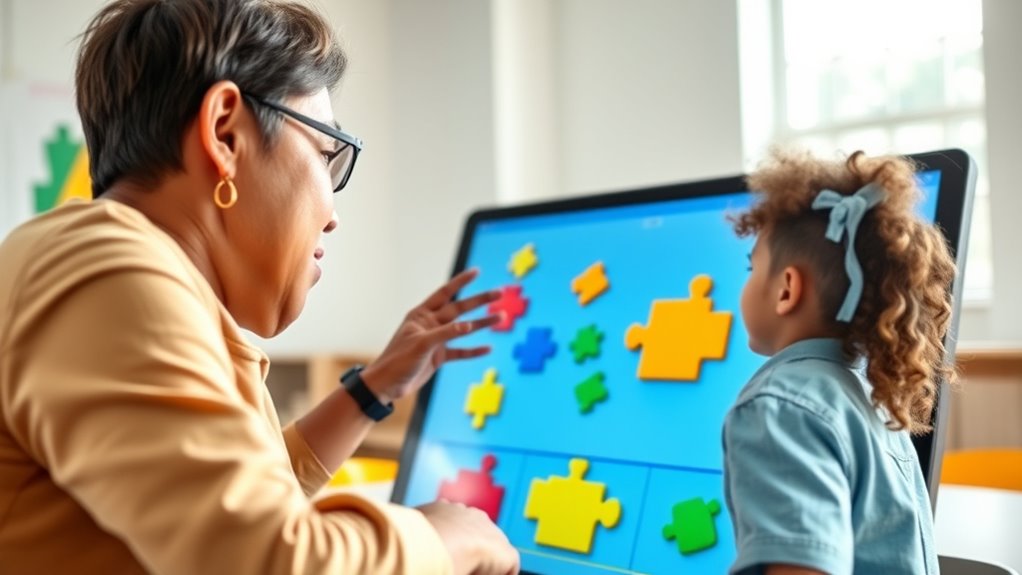
Are you wondering which visual programming tools are best for beginners? Several options make learning to code accessible and engaging. Block-based programming platforms like Scratch are popular for their intuitive drag and drop interfaces, allowing learners to focus on logic without worrying about syntax. Tynker offers similar features, with a user-friendly environment that encourages creativity. Blockly, developed by Google, provides customizable block-based programming suitable for various age groups. These tools simplify complex concepts by visually representing code, making it easier to understand and experiment. They foster problem-solving skills and build confidence early in the learning process. Whether you’re teaching young students or newcomers, these visual programming tools serve as excellent starting points for developing coding skills with minimal frustration. Diverse genres including action, romance, and fantasy enrich the storytelling experience and can inspire creativity in learners.
Strategies for Integrating Visual Languages Into Classroom Activities
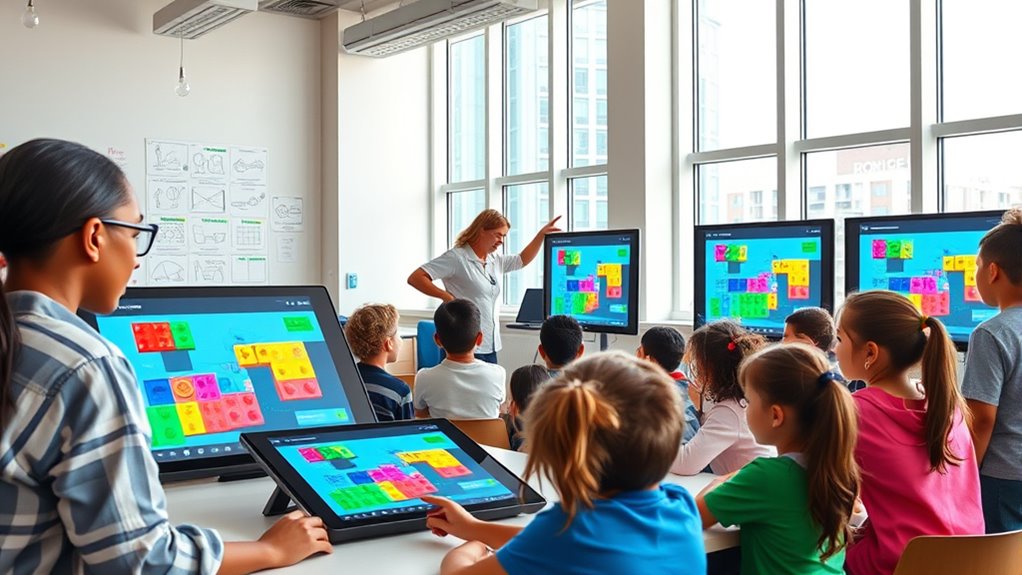
To effectively incorporate visual programming languages into classroom activities, you should design tasks that match students’ interests and skill levels. Start with block-based learning, which simplifies coding concepts and encourages exploration. Use interactive tutorials to guide students step-by-step, building confidence and understanding. Incorporate activities that foster collaboration and creativity, like group projects or problem-solving challenges. Here’s a simple framework to help you plan: Engaging narratives and the visual and auditory elements create a compelling experience.
| Strategy | Example |
|---|---|
| Block-based learning | Create simple animations or stories |
| Interactive tutorials | Use guided exercises for foundational skills |
| Scaffolded tasks | Gradually increase complexity |
| Collaborative projects | Pair students for peer learning |
| Real-world applications | Connect projects to students’ interests |
Examples of Projects and Activities Using Visual Programming

What engaging projects can you create to make the most of visual programming languages in your classroom? You can design exciting block-based projects that spark curiosity and creativity. For example, develop interactive storytelling activities that captivate students and encourage narrative thinking. These projects help learners see immediate results and build confidence. Consider activities like creating animated stories, interactive quizzes, or simple game prototypes. By using visual programming tools, you make complex concepts accessible and fun. Students love seeing their ideas come alive through visual elements, making learning memorable. Incorporating problem-solving skills into these projects fosters critical thinking and collaboration among students. Overall, integrating block-based projects and interactive storytelling into your lessons transforms coding from abstract to engaging, motivating students to explore further.
Overcoming Challenges When Teaching With Visual Languages
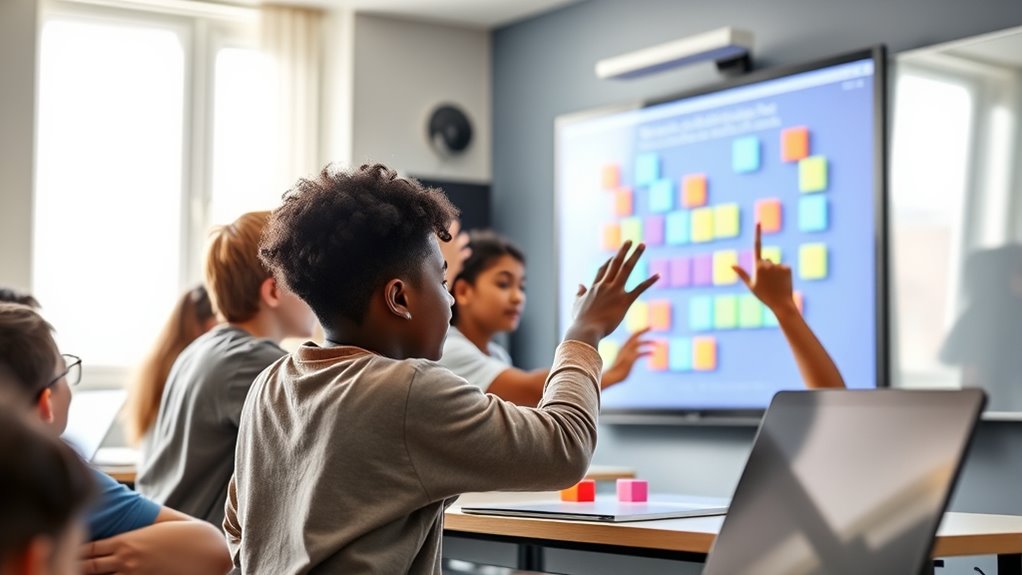
While visual programming languages make coding more accessible, teachers often face challenges in ensuring student engagement and understanding. One key issue is managing cognitive load; although visual languages simplify syntax, too many blocks or complex projects can overwhelm students. To overcome this, break tasks into smaller, manageable steps and focus on core concepts. Emphasize syntax simplicity by choosing intuitive tools that minimize unnecessary complexity. Encourage students to experiment and ask questions, fostering active learning. Additionally, provide clear instructions and real-world examples to make concepts relatable. Recognizing that visual languages are powerful but require thoughtful implementation helps you address these challenges effectively. By balancing simplicity with structured guidance, you can create an engaging environment that promotes confidence and deepens understanding. Regularly assessing and rotating items can help maintain an organized learning space, reducing distractions and supporting sustained focus.
Future Trends in Visual Programming Education
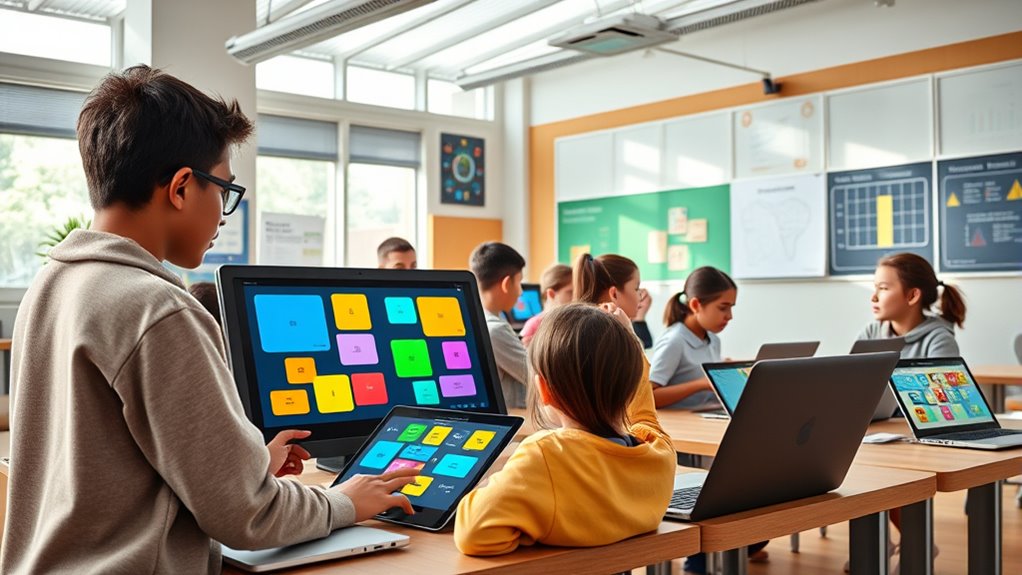
Emerging technologies and evolving educational needs are driving exciting developments in visual programming education. You’ll see a rise in the use of block-based syntax, making coding more accessible and intuitive for learners of all ages. Gamified learning continues to grow, engaging students through interactive challenges and rewards that boost motivation. Future trends include personalized learning experiences powered by AI, adapting to individual progress and interests. Additionally, immersive tools like virtual and augmented reality will create more engaging environments for visual programming, making abstract concepts tangible. These innovations will foster creativity, problem-solving, and confidence. Leveraging Hackathons as a collaborative learning environment can further accelerate skill development and innovation in visual programming education.
Frequently Asked Questions
How Do Visual Programming Languages Compare to Traditional Text-Based Coding?
When comparing visual programming languages to traditional text-based coding, you’ll find that visual languages use drag and drop interfaces, making it easier to understand program flow without worrying about syntax. You can focus on logic and problem-solving rather than memorizing complex syntax, which makes learning more accessible. While text-based coding offers more flexibility and control, visual, syntax-free programming is ideal for beginners and rapid prototyping.
What Age Groups Benefit Most From Visual Programming Education?
Think of learning to code as planting a seed; early childhood is the ideal time to nurture it. You’ll find that young children benefit most from visual programming, as it aligns with their rapid cognitive development. By using colorful, intuitive interfaces, you help them build foundational skills, boosting confidence and understanding. This early start sets the stage for more complex coding later, making learning both fun and effective.
Are There Any Drawbacks to Using Visual Languages in Teaching Coding?
When considering visual programming languages, you might encounter a few drawbacks. You could face a steeper learning curve for advanced concepts, making it harder to shift to text-based coding. Accessibility challenges may also arise, especially for learners with visual or motor impairments. However, these languages often make initial learning easier and more engaging, so weigh the benefits against potential limitations to find the best approach for your students.
How Can Teachers Assess Student Progress With Visual Programming Tools?
Imagine your students are stars, and you’re the night sky guiding them. To assess their progress with visual programming tools, you can use interactive rubrics that provide immediate feedback and clarity. Incorporate peer assessments to foster collaboration and self-awareness. These methods allow you to gauge understanding effectively, track growth over time, and guarantee each student’s unique journey is recognized, making learning both engaging and meaningful.
What Skills Beyond Coding Can Students Develop Through Visual Programming Activities?
When you explore skills beyond coding, you help students develop collaborative skills and problem-solving strategies. Through visual programming activities, they learn to work effectively with others, communicate ideas clearly, and approach challenges creatively. These activities foster critical thinking and teamwork, which are essential in many fields. By encouraging exploration and collaboration, you prepare students to apply their skills in real-world situations, setting a strong foundation for their future success.
Conclusion
As you explore teaching coding through visual programming languages, you’ll find that the right tools and strategies can unlock students’ creativity and confidence. Coincidentally, many students discover their passion for coding just when they see their ideas come to life visually. By embracing these approaches, you not only make learning more engaging but also open doors to future innovations. So, keep experimenting, because sometimes, a simple visual project sparks a lifelong love for programming.

